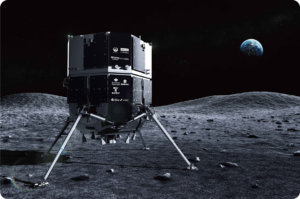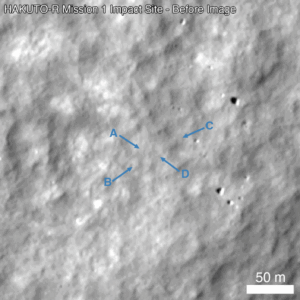NASA’s LRO Images Hakuto-R Lunar Crash Site
NASA’s Lunar Reconnaissance Orbiter has spotted the crash site of ispace’s Hakuto-R M1 lander on the surface of the Moon. Hakuto-R M1 is the first commercial spacecraft to land on the Moon, but not successfully. Radio transmissions monitored by amateur radio enthuasiasts suggest it ran out of fuel and made a hard landing. LRO’s images show four areas of disturbance where pieces apparently rest. NASA’s Lunar Flashlight, a completely separate cubesat that launched on the same rocket, also failed.
The robotic Hakuto-R Mission 1 spacecraft, built and owned by the Japanese company ispace, was launched on a SpaceX Falcon 9 rocket on December 11, 2022. The ispace lander carried the 10-kilogram Rashid rover from the United Arab Emirates and a tiny baseball-sized “transformer” rover, SORA-Q, developed by Japan’s space agency, JAXA, and toy company Takara Tomy.

The otherwise-unrelated Lunar Flashlight cubesat was launched on the same rocket. The briefcase-size spacecraft was intended to orbit the Moon and use four lasers to peer into crevices at the Moon’s South Pole to determine if water ice is present.
Although the launch was perfect, unfortunately none of the spacecraft fulfilled their missions.
Hakuto-R M1 successfully entered lunar orbit and began its powered descent to the surface on April 25 EDT (April 26 in Japan), but in the last moments contact was lost. ispace has not officially explained what happened, but a group of amateur radio observers who were monitoring the spacecraft’s radio transmissions during descent concluded it ran out of fuel.
Without propulsion to slow it down, it slammed into the surface instead of making a soft, survivable landing.
NASA and ispace already had made arrangements for LRO to image Hakuto-R M1 after it landed. Since it didn’t land where expected, it’s taken until now for scientists to study LRO images in that vicinity and detect changes in the surface after the crash.
Launched in 2009 and sending back detailed images of the lunar surface ever since, LRO is managed by NASA’s Goddard Space Flight Center. Arizona State University built the Lunar Reconnaissance Orbiter Camera, LROC, and analyzes imagery from it. Today they released before and after images of the area where Hakuto-R M1 crashed. The after image shows four white spots in the center that are believed to be the wreckage.

On the day of the failure, officials from ispace, while disappointed in the outcome, cited the many successes of the mission including reaching and entering lunar orbit and said they will use what they learned for their next two missions in 2024 and 2025. Founder and CEO Takeshi Hakamada vowed “We will keep moving forward.”
After NASA released the crash site imagery, the company tweeted its thanks and said it would be making an announcement on Friday, May 26, to share its analysis of what happened.
Thank you @NASAMoon and LRO Team for following our mission and sharing our lander’s location on the Moon.
We have been conducting a thorough analysis of the flight data received during M1’s operation and will announce the results on May 26th. Stay tuned for updates. https://t.co/ZZeRsg4Sg4
— ispace (@ispace_inc) May 24, 2023
The success rate for small, inexpensive, innovative robotic spacecraft sent on journeys beyond Earth orbit is not great so far. There have been some successes — NASA’s CAPSTONE now in lunar orbit, Italy’s LICIACube that accompanied the DART mission and sent back images of Dimorphos after the impact, and the two MarCO cubesats that followed NASA’s InSight mission to Mars and served as communications relays as they flew past the planet — but there have been many more failures.
Hakuto-R M1 is the third small lunar lander in a row to crash. Israeli non-profit Space IL’s Beresheet and the Indian Space Research Organisation’s Chandrayaan-2 similarly failed in 2019. In addition, JAXA’s OMOTENASHI, a lunar lander that was one of 10 cubesats launched on the Artemis I mission last year, failed because stable communications could not be established. Most of the other Artemis I cubesats also failed.
ISRO plans to try again with Chandrayaan-3 this summer. SpaceIL has been working on a second Beresheet for launch in 2025, but reports from Israel last week indicated the main donors have backed out.
SpaceIL and ispace both began as part of the Google Lunar X-Prize, which ended in 2018 with no winners of the grand prize.
Another entrant in that competition was the U.S. company Astrobotic, which is getting ready to launch its first robotic lunar lander as part of NASA’s Commercial Lunar Payload Services (CLPS) program. The Peregrine lander will be launched on the first flight of the United Launch Alliance’s Vulcan rocket and the launch date is dependent on when ULA is ready, but could come as early as this summer.
NASA has embraced the smallsat/cubesat revolution to support the Artemis program to return astronauts to the lunar surface for sustained exploration and utilization of lunar resources. Several other U.S. companies also are participating in the CLPS program of robotic lunar landers and NASA has other efforts underway for orbiters.
CAPSTONE turned out to be a success story although they were plenty of travails along the way. Conversely, NASA’s recent decision to terminate efforts to get Lunar Flashlight into lunar orbit is a setback.

The $27 million Lunar Flashlight tagged along as a rideshare on the SpaceX Falcon 9 rocket that launched Hakuto-R M1. Although it correctly separated from the rocket’s second stage, the cubesat’s propulsion system was unable to generate enough thrust to enter lunar orbit. NASA’s Jet Propulsion Laboratory said it probably was due to debris in the thruster lines. The spacecraft was a technology demonstration and the propulsion system and fuel were being used for the first time beyond Earth orbit.
This article has been updated.
User Comments
SpacePolicyOnline.com has the right (but not the obligation) to monitor the comments and to remove any materials it deems inappropriate. We do not post comments that include links to other websites since we have no control over that content nor can we verify the security of such links.